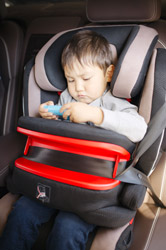Using Child Car Seats

By law, your child must use the child car seat for every single journey, no matter how short.
Make sure the child car seats is fitted securely, according to the manufacturer's instructions. The advice in the "Fitting Child Car Seats" section of this website will also help.
Take time to get your child comfortably strapped in.
Seats with an Integral harness
- The top of the harness should be about 2cm below the shoulder of a child in a rear-facing child car seat, and about 2cm above the shoulder of a child in a forward-facing child car seat.
- It should be quite tight, so that only one or two fingers can fit between the child's chest and harness.
- Clothing can affect how snugly the harness fits, so check it every journey.
- The harness buckle should not rest over the child's tummy.

Seats with an Impact Shield
- These seats use an impact cushion or shield to hold the child in place, rather than a harness.
- The shield is normally secured by the car's seat belt, so follow the instructions carefully.
Booster Seats and Cushions
- The car's seat belt goes around both the child and the booster seat or booster cushion.
- The seat belt should be worn as tight as possible
- The lap belt should go over the pelvic region (from hip-bone to hip-bone), not the stomach
- The diagonal strap should rest on the child's shoulder, not the neck (most seats have a slot or a clip to help position the belt.
 Never tuck the seatbelt under the child's arm or behind their back.
Never tuck the seatbelt under the child's arm or behind their back.- Some children go through a phase of slipping out of the harness or releasing the buckle. But do not modify the buckle to prevent this; you might affect the quick release mechanism. See the Children Undoing their harness for more advice.
Always set a good example by wearing your seat belt
